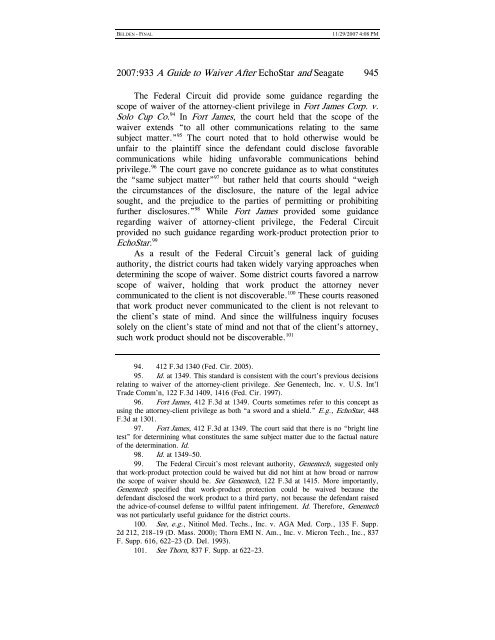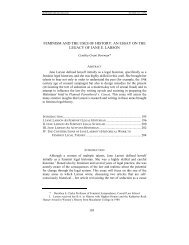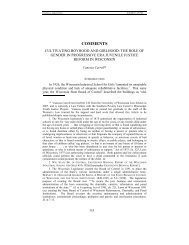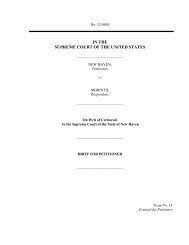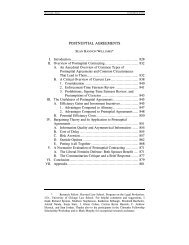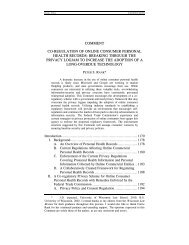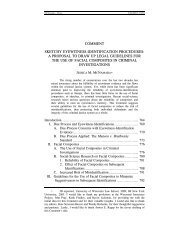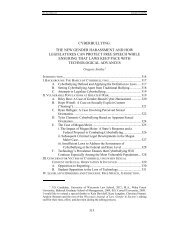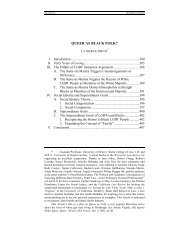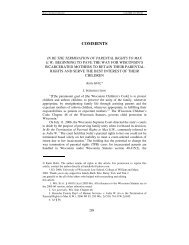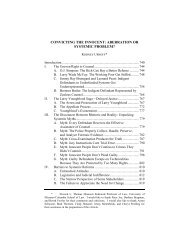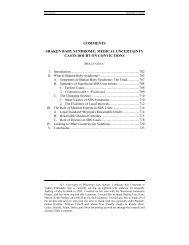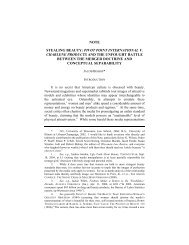note a guide to waiver after echostar and seagate - UW Law School
note a guide to waiver after echostar and seagate - UW Law School
note a guide to waiver after echostar and seagate - UW Law School
You also want an ePaper? Increase the reach of your titles
YUMPU automatically turns print PDFs into web optimized ePapers that Google loves.
BELDEN - FINAL 11/29/2007 4:08 PM<br />
2007:933 A Guide <strong>to</strong> Waiver After EchoStar <strong>and</strong> Seagate 945<br />
The Federal Circuit did provide some guidance regarding the<br />
scope of <strong>waiver</strong> of the at<strong>to</strong>rney-client privilege in Fort James Corp. v.<br />
Solo Cup Co. 94 In Fort James, the court held that the scope of the<br />
<strong>waiver</strong> extends “<strong>to</strong> all other communications relating <strong>to</strong> the same<br />
subject matter.” 95 The court <strong>note</strong>d that <strong>to</strong> hold otherwise would be<br />
unfair <strong>to</strong> the plaintiff since the defendant could disclose favorable<br />
communications while hiding unfavorable communications behind<br />
privilege. 96 The court gave no concrete guidance as <strong>to</strong> what constitutes<br />
the “same subject matter” 97 but rather held that courts should “weigh<br />
the circumstances of the disclosure, the nature of the legal advice<br />
sought, <strong>and</strong> the prejudice <strong>to</strong> the parties of permitting or prohibiting<br />
further disclosures.” 98 While Fort James provided some guidance<br />
regarding <strong>waiver</strong> of at<strong>to</strong>rney-client privilege, the Federal Circuit<br />
provided no such guidance regarding work-product protection prior <strong>to</strong><br />
EchoStar. 99<br />
As a result of the Federal Circuit’s general lack of guiding<br />
authority, the district courts had taken widely varying approaches when<br />
determining the scope of <strong>waiver</strong>. Some district courts favored a narrow<br />
scope of <strong>waiver</strong>, holding that work product the at<strong>to</strong>rney never<br />
communicated <strong>to</strong> the client is not discoverable. 100 These courts reasoned<br />
that work product never communicated <strong>to</strong> the client is not relevant <strong>to</strong><br />
the client’s state of mind. And since the willfulness inquiry focuses<br />
solely on the client’s state of mind <strong>and</strong> not that of the client’s at<strong>to</strong>rney,<br />
such work product should not be discoverable. 101<br />
94. 412 F.3d 1340 (Fed. Cir. 2005).<br />
95. Id. at 1349. This st<strong>and</strong>ard is consistent with the court’s previous decisions<br />
relating <strong>to</strong> <strong>waiver</strong> of the at<strong>to</strong>rney-client privilege. See Genentech, Inc. v. U.S. Int’l<br />
Trade Comm’n, 122 F.3d 1409, 1416 (Fed. Cir. 1997).<br />
96. Fort James, 412 F.3d at 1349. Courts sometimes refer <strong>to</strong> this concept as<br />
using the at<strong>to</strong>rney-client privilege as both “a sword <strong>and</strong> a shield.” E.g., EchoStar, 448<br />
F.3d at 1301.<br />
97. Fort James, 412 F.3d at 1349. The court said that there is no “bright line<br />
test” for determining what constitutes the same subject matter due <strong>to</strong> the factual nature<br />
of the determination. Id.<br />
98. Id. at 1349–50.<br />
99. The Federal Circuit’s most relevant authority, Genentech, suggested only<br />
that work-product protection could be waived but did not hint at how broad or narrow<br />
the scope of <strong>waiver</strong> should be. See Genentech, 122 F.3d at 1415. More importantly,<br />
Genentech specified that work-product protection could be waived because the<br />
defendant disclosed the work product <strong>to</strong> a third party, not because the defendant raised<br />
the advice-of-counsel defense <strong>to</strong> willful patent infringement. Id. Therefore, Genentech<br />
was not particularly useful guidance for the district courts.<br />
100. See, e.g., Nitinol Med. Techs., Inc. v. AGA Med. Corp., 135 F. Supp.<br />
2d 212, 218–19 (D. Mass. 2000); Thorn EMI N. Am., Inc. v. Micron Tech., Inc., 837<br />
F. Supp. 616, 622–23 (D. Del. 1993).<br />
101. See Thorn, 837 F. Supp. at 622–23.


